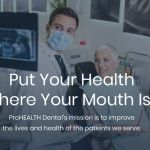How to Identify Gum Disease Early and Get Treatment – Protect Your Oral Health
Gum disease is a common yet serious oral health issue that can lead to tooth loss if left untreated. Recognizing the signs of gum disease early and seeking treatment is crucial for maintaining healthy gums and teeth. In this article, we will explore how to identify gum disease early, the common symptoms to watch for, and the most effective treatments to prevent further damage.
1. What Is Gum Disease and Why Is Early Detection Important?
Gum disease, also known as periodontal disease, is an infection of the gums and surrounding tissues. It is caused by bacteria from plaque buildup that irritates the gums and leads to inflammation. Gum disease typically progresses in two stages: gingivitis (the mildest form) and periodontitis (the more severe form). Early detection of gum disease is essential, as it can help prevent the condition from progressing to periodontitis, which can lead to tooth loss and other complications.
2. Early Signs of Gum Disease to Watch For
Recognizing the early signs of gum disease can help you get treatment before it becomes severe. Here are some common symptoms that may indicate the presence of gum disease:
- Bleeding Gums: One of the earliest signs of gum disease is bleeding gums, especially when brushing or flossing. This occurs due to inflammation of the gum tissue.
- Red, Swollen Gums: Healthy gums are firm and pink. If your gums are red, swollen, or tender, it could be a sign of gum disease.
- Bad Breath: Persistent bad breath or a bad taste in the mouth can be caused by the bacteria in plaque and the infection in the gums.
- Receding Gums: If your gums are pulling away from your teeth, exposing more of the tooth or even the tooth root, this may indicate gum disease.
- Loose Teeth: In advanced stages of gum disease, the gums can lose their grip on the teeth, causing them to become loose or shift positions.
3. How to Identify Gum Disease Early with Regular Dental Checkups
The best way to identify gum disease early is by visiting your dentist regularly for checkups. During these visits, your dentist will assess the health of your gums and look for signs of infection. Regular dental cleanings help remove plaque and tartar, which can prevent gum disease from developing. Your dentist may also use special tools to measure the depth of the spaces between your teeth and gums (known as pocket depths) to assess the severity of any existing gum disease.
4. Treatment Options for Gum Disease
If you notice any of the early signs of gum disease, it's important to seek treatment as soon as possible. Treatment options vary depending on the severity of the disease:
- Professional Cleaning (Scaling and Root Planing): For early-stage gum disease (gingivitis), a thorough cleaning by your dentist can remove plaque and tartar buildup, allowing the gums to heal and return to health.
- Medications: Your dentist may prescribe antimicrobial mouthwash, oral antibiotics, or other medications to help treat the infection and reduce inflammation.
- Non-Surgical Gum Treatments: For more advanced cases, procedures like scaling and root planing can be done to clean the deep pockets between teeth and gums.
- Gum Surgery: In severe cases of periodontitis, surgery may be necessary to remove infected tissue and restore gum health.
5. Real-Life Case: How Early Detection Helped Prevent Severe Gum Disease
Consider the case of John, a 40-year-old man who visited his dentist after noticing bleeding gums while brushing his teeth. His dentist identified early-stage gingivitis and performed a thorough cleaning to remove plaque and tartar. With the proper care, John’s gums healed, and he avoided more serious treatments like gum surgery. This case highlights the importance of early detection and the effectiveness of professional cleaning in preventing the progression of gum disease.
6. Tips for Preventing Gum Disease and Maintaining Healthy Gums
Preventing gum disease is much easier than treating it. Here are some steps you can take to protect your gums and keep them healthy:
- Brush Your Teeth Twice a Day: Use a soft-bristled toothbrush and fluoride toothpaste to brush your teeth thoroughly for at least two minutes.
- Floss Daily: Flossing helps remove plaque and food particles from between your teeth, where your toothbrush can’t reach.
- Quit Smoking: Smoking weakens your immune system and increases the risk of gum disease. Quitting smoking can significantly improve your gum health.
- Maintain a Healthy Diet: A balanced diet rich in vitamins and minerals, especially vitamin C, can help keep your gums healthy and reduce inflammation.
- Regular Dental Visits: Seeing your dentist every six months for checkups and cleanings can help catch early signs of gum disease and prevent serious complications.
7. Conclusion: Early Action Is Key to Healthy Gums
Identifying gum disease early and getting treatment is essential for protecting your oral health and preventing further damage. If you notice any signs of gum disease, such as bleeding gums, bad breath, or gum recession, don’t wait—schedule an appointment with your dentist as soon as possible. With early intervention and proper care, you can keep your gums healthy and avoid the complications of gum disease. For more information on how to care for your gums, visit Dentistry Toothtruth and discover our range of dental care products and services designed to keep your smile healthy.







 Holmes & Palmer Orthodontics - Charleston5.0 (577 review)
Holmes & Palmer Orthodontics - Charleston5.0 (577 review) Robbinsville Pediatric Dentistry4.0 (306 review)
Robbinsville Pediatric Dentistry4.0 (306 review) Bradford Orthodontics - Thomas Ferlito DMD4.0 (38 review)
Bradford Orthodontics - Thomas Ferlito DMD4.0 (38 review) ProHEALTH Dental4.0 (506 review)
ProHEALTH Dental4.0 (506 review) Flanders Pediatric Dentistry4.0 (210 review)
Flanders Pediatric Dentistry4.0 (210 review) Perfect Smile Dental Care4.0 (487 review)
Perfect Smile Dental Care4.0 (487 review) The Importance of Oral Health Education During Pregnancy for a Healthy Pregnancy
The Importance of Oral Health Education During Pregnancy for a Healthy Pregnancy Best Tips for Brushing Your Teeth Properly for Healthy Gums: Essential Techniques for Oral Health
Best Tips for Brushing Your Teeth Properly for Healthy Gums: Essential Techniques for Oral Health Why Skipping Dental Checkups Can Lead to Bigger Oral Health Problems
Why Skipping Dental Checkups Can Lead to Bigger Oral Health Problems Advantages of Porcelain Dental Restorations
Advantages of Porcelain Dental Restorations How Can Diabetes Cause Tooth and Gum Problems? Preventing and Managing Oral Health Issues
How Can Diabetes Cause Tooth and Gum Problems? Preventing and Managing Oral Health Issues Healthy Habits for Promoting Good Oral Health and Hygiene: Tips for a Healthy Smile
Healthy Habits for Promoting Good Oral Health and Hygiene: Tips for a Healthy Smile